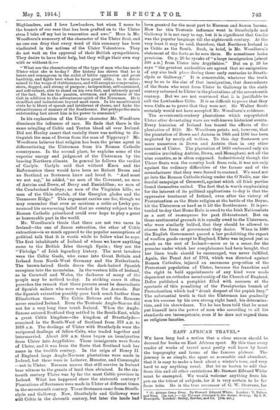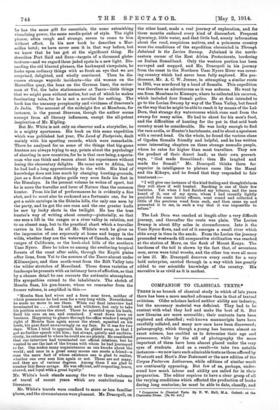EAST AFRICAN TRAVEL.*
WE have long had a notion that a close season should be decreed for books on East African sport. By this time every reader of works of travel must pretty well know by heart the topography and fauna of the famous plateau. The journey is so simple, the sport so accessible and abundant, that it is easy to make a book about a winter's tour, and very hard to say anything novel. But let us hasten to add that from this and all other restrictions Mr. Stewart Edward White must be exempted. We would welcome anything from his pen on the tritest of subjects, for it is very certain to be far from trite. He is the true successor of G. W. Steevens, for • (1) African Can Fires. By Stewart Edward White. London Nelson and Sous. [5e.met.j—(2) Through Jsbakuld to Oa Lorion Strew, By 1. N. DraeopolL -London: Seeley, Serves, and Co. Dee. net.] he has the same gift for essentials, the same astonishing visualizing power, the same needle-point of style. The right phrase, often rough and strange, seems to come to him without effort. In his new book he describes a Mar- seilles hotel; we have never seen it in that way before, but we know that he has got at the significant thing. He describes Port Said and Suez—targets of a thousand globe- trotters—and we regard these jaded spots in a new light. Dis- carding the old blurred phrases, the hackneyed viewpoints, he looks upon ordinary things with so fresh an eye that we are surprised, delighted, and wholly convinced. Then he dis- cusses strange wayside incidents—the old woman on the Marseilles quay, the hoax on the German liner, the motor- man at Poi, the balm stationmaster at Tsavo—little things that we might pass without notice, but out of which he makes fascinating tales, for he is not a novelist for nothing. The book has the uncanny perspicacity and vividness of Steevens's In India. The account of the midnight fire at Mombasa, for instance, is the purest Steevens, though the author seems exempt from all literary influences, except the all-potent inspiration of Mr. Kipling.
But Mr. White is not only an observer and a storyteller, he is a mighty sportsman. His book on this same expedition which was published last year, The Land of Footprints, dealt mainly with his sporting records, which were remarkable. There he analysed for us some of the things that big-game bunters are always trying to say, points about the psychology of shooting in new countries, for he is that rare being, a sports- man who can think and reason about his experiences without losing the elementary delights. He came new to Africa, but he had bad a long apprenticeship to the wilds. His kind of knowledge does not lose much by changing hunting-grounds, just as a first-class Alpine guide very soon finds his feet in the Himalaya. In the present volume he writes of sport, but he is more the traveller and lover of Nature than the common hunter. From his list of performances he is evidently a fine shot, and be must also be reckoned as a fortunate one, for he got a sable antelope in the Shimba hills, the only one seen by the party, and he got the one roan and the one greater hula be saw by lucky shots in the twilight. He has the true bunter's way of writing about country—pictorially, so that one sees a lift in the ranges or a river valley in relation, not to an absent map, but to the practical chart which a traveller carries in his head. In all Me. White's work he gives us the impression of one supremely at home and happy in the wilds, whether they are the waterways of Canada, or the coast ranges of California, or the bush-clad hills of the southern Base Nyero. Here he takes us among the sweltering tropical forests of the coast after sable, through the Kapiti plains after lions, from Voi to the sources of the Tsavo almost under Kilimanjaro, and then south-west from the Rift Valley into the wilder stretches of Masailand. These dozen varieties of landscape he presents with an intimacy born of affection, so that by a chance detail he can recreate the authentic atmosphere. His sympathies extend to the inhabitants. The sketch of Memba Sasa, his gun-bearer, whom we remember from the former volume, is amplified in this :—
"Memba Sass had wives and a farm near town, neither of which possessions he had seen for a very long while. Nevertheless be made no move to see them. When our final interview had terminated he . . . shook hands and withdrew, but only to take his position across the street. There he squatted 'upon his heels, fixed his eyes on me, and remained. I went down town on business. Happening to glance through the office window I caught sight of Memba Sasa again across the street, squatted on his heels, his gaze fixed unwaveringly on my face. So it was for two days. When I tried to approach him he glided away, so that I got no further speech with him; but always, quietly and unobtru- sively, he returned to where he could see me plainly. He considered that our interview had terminated our official relations, but he wanted to see the brat of the bwana with whom he had journeyed so far. One makes many acquaintances as one knocks about the -world ; and once in a great many moons one meets a friend—a .man the mere fact of whose existence one is glad to realize, whether one ever sees him again or not. These are not many, and they are of various degrees. Among them I am glad to number this fierce savage. He was efficient, self-respecting, brave, 'shrewd, and loyal with a great loyalty."
Mr. White's book stands among the two or three volumes of travel of recent years which are contributions to literature.
Mr. White's travels were confined to more or less familiar -places, and the circumstances were pleasant. Mr. Dracopoli, on
the other hand, made a real journey of exploration, and for three months endured every kind of discomfort. Frequent dysentery, little water, and that little bad, scanty information about time road, auspicious natives, and a poisonous country were the conditions of the expedition chronicled in Through Jubaland to the Lorian Swamp. Jubaland is the north- eastern corner of the East Africa Protectorate, bordering on Italian Somaliland. Only the western portion has been surveyed and mapped, and Mr. Dracopoli in his journey from the coast to the Northern Uaso Nyero River was cover- ing country which had never been fully explored. His pre- decessor, Mr. A. C. W. Jenner, in attempting a similar route in 1905, was murdered by a band of Somalis. This expedition was therefore as adventurous as it was arduoue. He went by sea from Mombasa to Kismayu, where he collected his caravan, which included four Somali police. He at first intended to go to the Lorian Swamp by way of the Tana Valley, but found on the way that he might be able to reach it by means of the Lak Dera, that strange dry watercourse which runs east from the swamp for many miles. He had to shoot for his men's food, and the difficulties of hunting for the pot in that arid bush country must be considerable. He was lucky enough to find the rare arolla, or Hunter's hartebeeste, and to shoot a specimen with a record head. On the whole, be found the various clans of Ogaden Somalia friendly and helpful, and he has written some interesting chapters on these strange nomadic people, whom he rates far higher than most travellers. They are the product of their• desert land; as their own proverb says, " God made Somaliland : then He laughed and made the Somali." Mr. Dracopoli thinks them far superior in intelligence to plateau races like the Masai and the Kikuyu, and he found that they responded to fair treatment :— "I will give one instance of the kind feeling and thoughtfulness they will show if well treated. Smoking is one of their few luxuries. Yet when I had finished my tobacco, and the men heard of it, one of my syces, whom I had recently lightly punished for some trivial offence, went round and collected a little of the precious weed from each, and then came up and presented it to me, in such a way that it was impossible to refuse."
The Lak Dera was reached at length after a very difficult journey, and thereafter the route was plain. The Lorian Swamp is about fifty miles in circumference. Into it the 1Jaso Nyero flows, and out of it emerges a small river which ebbs away in time in the sands. From the Lorian the journey proceeded westwards till comparative civilization was reached at the station of Meru, on the flank of Mount Kenya. The hardness of the toil is shown by the fact that, of seventeen men, seven were total wrecks, and the other ten were all more or less ilL Mr. Dracopoli deserves every credit for a very bold enterprise, carried through in a way which has greatly added to our scientific knowledge of the country. His narrative is as vivid as it is modest.















































 Previous page
Previous page